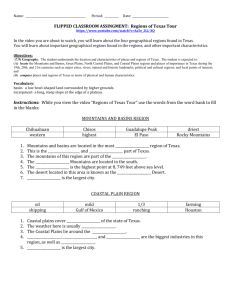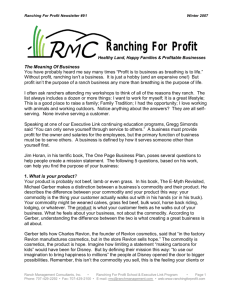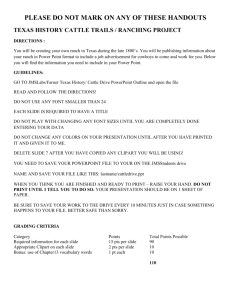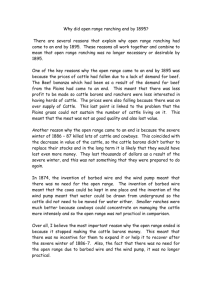7 - Institute of Texan Cultures
advertisement
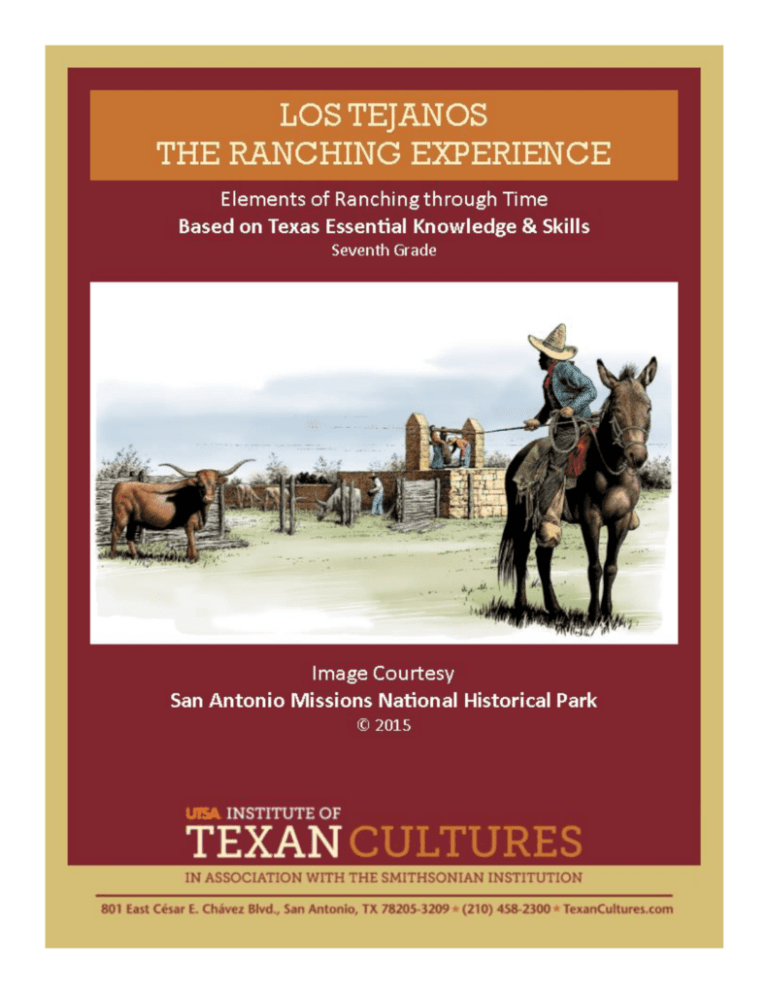
Institute of Texan Cultures The Ranching Experience 0 Introduction Dear Educator, Los Tejanos: The Ranching Experience explores the legacy of ranching from a unique cultural perspective and offers students a glimpse into what life was like for people working and thriving on Texas ranches. This resource guide provides students with learning activities that give them the opportunity to engage with the past, where they will refine critical thinking skills while learning about the value of work as an aspect of Tejano culture. The contents of this guide are based on Social Studies and English Language Arts and Reading TEKS for grades 7, but some activities may be modified for lower or higher grades. For additional resources and information on ITC exhibits and tours, please visit http://www.texancultures.com/resources/ If you have any questions or would like more information on materials, resources and services for students and educators, please do not hesitate to contact us. Respectfully, The Institute of Texan Cultures Education and Interpretation 210.458.2281 itceducation@utsa.edu Table of Contents Introduction ............................................................................................................................................................................ 1 Using This Educator Guide ...................................................................................................................................................... 2 Contributions of the Vaqueros............................................................................................................................................ 3 Ranching Advertisement Analysis ....................................................................................................................................... 5 Taking Care of Your Cattle .................................................................................................................................................. 6 Elements of Ranching through Time ................................................................................................................................. 10 Elements of Ranching through Time – Chart .................................................................................................................... 11 Changes in Ranching Writing ............................................................................................................................................ 12 References ............................................................................................................................................................................ 13 Texas Essential Knowledge and Skills.................................................................................................................................... 13 Institute of Texan Cultures The Ranching Experience 1 Using This Educator Guide Los Tejanos: The Ranching Experience features a series of activities for use in the classroom. These activities, developed for grades 7, are designed to help students understand the contributions of the cowboy or vaquero and learn about the important role innovation played in the development of the Texas ranching industry. While these activities are designed to be completed as an entire series, please feel free to modify and/or expand upon them to meet your classroom needs. Background Information: During the early period of Spanish settlement in the New World, large landowners and missionaries typically hired “laborers on horseback” or vaqueros to work their ranches. A vaquero typically wore a bandana, a sarape, spurs, and a stylish sombrero. His leather leggings gave rise to chaparreras, or chaps. The vaqueros also established practices for rounding up and branding livestock. After centuries of ranching practice in Mexico, the vaqueros arrived in Texas and the Texan cowboy was born. Many practices of the vaqueros were used by early Texan cowboys and are still commonplace today. Since then, ranching has continually evolved. First came fences, then windmills, then electricity. Brands are being replaced by computer chips. Cowboys now use smart phones, ATVs, and helicopters. “Honking up” the cattle with a truck is more common these days than driving them in on horseback. Despite the changes, many traditions remain. Livestock must still be rounded up, brought in, and taken to market. Ranchers still dress much like their vaquero predecessors. Many everyday words on the ranch, like lariat, bronco, chaps, or rodeo, tie directly back to Spanish. More profoundly, what has not changed is the longing to connect to something larger – the past and the future. There remains a yearning to work land cared for by ancestors, and to pass that legacy to generations yet to come. Ranching remains the heartbeat and soul of Texas. Goals & Objectives: The following goals and objectives are woven throughout the lessons provided in this guide. These objectives help students identify and connect with important thematic concepts that will come up throughout their studies in history and culture. Tejanos created a lasting impact on Texan culture through ranching. Many early elements of ranching are still an important part of the modern Texas ranching experience. There are positive and negative impacts on the Texan ranching experience from the innovations in technology and tools. Classroom Activities: Contributions of the Vaqueros – This activity allows students to think about the Tejano’s contribution to ranching through critical thinking questions. Ranching Advertisement Analysis – Students will analyze the elements and effectiveness of a ranching advertisement and think about how modern items are advertised. For a modern ad, go to http://circlearanch.com/recent-ads/ Taking Care of Your Cattle – Students will think about the positive and negative impact of innovations through ranching by looking at how to handle cattle in early Texas ranching. Elements of Ranching through Time & Changes in Ranching Writing Activity – Students will research and present an element of ranching to understand the important innovations in ranching through time. After completing their presentations students will have a chance to reflect on their learning through a writing assignment. Institute of Texan Cultures The Ranching Experience 2 Name: ____________________________________________________________ Date: _____________ Contributions of the Vaqueros Directions: Read the passage below and answer the questions. SPANISH RANCHING IN TEXAS, 1762 Perhaps no other Spanish industry left such an important legacy to Texas as ranching. There had been an effort to introduce livestock to Texas as early as 1690, but only after the colonization of the Canary Islanders did cattle raising become a major endeavor. Ranches were established along the grasslands of the San Antonio River between Bexar and La Bahia. Others were located in the Escandon Grant, and on the Texas side of the Rio Grande from Laredo to the Gulf. In addition to numerous individuals who maintained pastures south of Bexar, the missions also had ranches where they kept herds of cattle, sheep, goats, oxen, horses, and mules. The herds constituted the main wealth of the missions and served as one of the bases for their economy. Besides establishing large ranches and stocking them, the Spanish also introduced many practices which became western traditions. It was the Spanish "vaquero" who came with the riding equipment that later was modified for use by the American cowboy. It was the vaquero who was proficient with a "reata" and kept a “remuda" of horses as spare mounts. It was the vaquero who initiated the practice of the roundup and branding to identify one's livestock. Don Juan Joseph Flores, a prominent rancher of the area south of San Antonio, was responsible for registering the first Texas-owned brand at Bexar in 1762. In addition to branding, the Spanish also introduced the first "Stockmen's Association" to Texas the "mesta." Since there was a market for the cattle in other locations, and a surplus in the San Antonio area, it was natural that the trail drive should develop. There is evidence of a drive from Bexar to Coahuila as early as 1770, but the first officially sanctioned cattle drive seems to have occurred in 1779, when Francisco Garcia was commissioned to drive 2,000 head of cattle eastward to Louisiana. It was through the efforts of men like these that the great cattle ranches became a part of the Texas image. -From ITC’s The Spanish Texans 1. Why was ranching important to Texas? ___________________________________________________________________________________________ ___________________________________________________________________________________________ 2. What contributions did the vaqueros make to ranching? ___________________________________________________________________________________________ ___________________________________________________________________________________________ 3. Based on the text, what is the purpose of a cattle drive? Why do you think that? ___________________________________________________________________________________________ ___________________________________________________________________________________________ 4. Use the text to come up with your own definition of the words below, then research the word to determine the actual definition. a. Reata: i. My definition: ______________________________________________________________________ ii. Researched definition: _______________________________________________________________ b. Remuda: i. My definition: ______________________________________________________________________ ii. Researched definition: _______________________________________________________________ Institute of Texan Cultures The Ranching Experience 3 5. Who was the first person to register the first Texas-owned brand? When did this occur? ___________________________________________________________________________________________ ___________________________________________________________________________________________ 6. Read the definition of branding and answer the question below: Branding: The technique of marking an animal to identify the owner. Why was branding important to a rancher? What are some benefits to branding? ___________________________________________________________________________________________ ___________________________________________________________________________________________ ___________________________________________________________________________________________ 7. Look at the branding images in the text, do you think the brands were easily understandable by others? Why or why not? ___________________________________________________________________________________________ ___________________________________________________________________________________________ ___________________________________________________________________________________________ ___________________________________________________________________________________________ Extension Questions: Research the following questions. 8. How did the colonization of the Canary Islanders spark the introduction of cattle to Texas? ___________________________________________________________________________________________ ___________________________________________________________________________________________ ___________________________________________________________________________________________ ___________________________________________________________________________________________ 9. Reread the text below and answer the question: “Ranches were established along the grasslands of the San Antonio River between Bexar and La Bahia. Others were located in the Escandon Grant, and on the Texas side of the Rio Grande from Laredo to the Gulf.” Why were ranches established in these locations? What were some benefits to being in these locations? Where there any consequences? ___________________________________________________________________________________________ ___________________________________________________________________________________________ ___________________________________________________________________________________________ ___________________________________________________________________________________________ 10. How has branding evolved since 1762? Are the same types of images used? Are the same techniques used? ___________________________________________________________________________________________ ___________________________________________________________________________________________ ___________________________________________________________________________________________ ___________________________________________________________________________________________ Institute of Texan Cultures The Ranching Experience 4 Name: ____________________________________________________________ Date: _____________ Ranching Advertisement Analysis Directions: Use the advertisement below then answer the questions. Basic Elements of an Advertisement What is it an advertisement for? List the information the advertisement provides about the product. What images has the advertiser chosen to use? Why? How does the advertisement attempt to get your attention? Who do you think is the target audience for this product? Where do you think the advertisement was printed? (In a magazine, newspaper, catalogue, etc.) Thinking about Modern Advertisements How does the language in the advertisement differ from Would this advertisement be successful today? Why or the language we use today? why not? Why is it so different from modern advertisements? Extension Activity: Think about how you could turn this advertisement in a successful modern ad. What would you need to include or add to the current advertisement to gain the attention of the target audience? On a separate piece of paper or the computer, use the elements of this advertisement to make a modern version of the advertisement. Be sure to include important information from this advertisement. Institute of Texan Cultures The Ranching Experience 5 Name: ____________________________________________________________ Date: _____________ Taking Care of Your Cattle BRANDING Fun Fact: A hundred and thirty years ago Samuel A. Maverick was rated one of Texas's largest landowners. Though not a rancher, he once took a herd of cattle in payment of a debt and put them on his place below San Antonio, where they thrived, multiplied and wandered away. The calves were not branded and neighbors said "they're Maverick's." Today a "maverick" still means an unbranded calf or an independent person. – Reflections of Texas You do not want “mavericks”. If you were in the cattle business, you would need a brand to help prevent rustlers from stealing your cattle. Before the 1880’s in the era of the open range, cattle branding was necessary to keep stock separated. But the famous western cattle brands weren’t the only ones in Texas. Spanish American ranchers used elaborate and decorative designs, sometimes covering the entire side of a steer. – Reflections of Texas Take a look at some of these famous Texas brands. Brands can include letters, numbers, lines & circles, and pictures. While it was important to keep the brand simple and easy to read, it was also important to make a brand that was difficult for rustlers to alter. Here are a few basic rules on how to read brands: Directions: Try reading a few famous brands. 1. _________________Hint: Read outside to inside 3. ________________ Hint: A picture 2. _________________Hint: Read top to bottom 4. ________________ Hint: A shape and a letter Your brand identifies cattle as your property, but as you can see, sometimes brands are not always easy to read. Cattle companies and ranches did not always use their names for their brand, but their brand still represented them. Institute of Texan Cultures The Ranching Experience 6 MARK AND BRAND APPLICATION Directions: Rules and regulations are set in place so there won’t be more than one style of brand. You need to fill out the form to register your brand with the teacher. THIS FORM MUST BE SUBMITTED TO THE COUNTY CLERK IN THE COUNTY IN WHICH YOUR LIVESTOCK RESIDE. The undersigned hereby makes application for the registration and recording of the following mark(s) and/or brand(s) by the County Clerk of ___________________ County, Texas: New: Renewal: Release: Transfer: Contact Information: Owner: __________________________________ Ranch Name: ______________________________________ Phone: ______________ Address: __________________________ City: _____________ Zip Code: __________ Brand/Mark: In the space provided, create a design that represents you. After you draw your brand, write a brief explanation of your design. Don’t forget to indicate (with a circle) where you will place the brand on the cattle. Remember to make the brand simple and easy to read. Male_____ *Specie: Female______ (gender of cattle) Cattle: Brief explanation of design: ____________________________________________ ____________________________________________ ____________________________________________ ____________________________________________ ____________________________________________ Signature of Applicant: ____________________________________________________ Date______________ Adapted from http://www.tscrabrands.com/application.pdf Institute of Texan Cultures The Ranching Experience 7 MAKING A PROFIT Cowboys would drive cattle on cattle trails across the open range to make it to a “cow town”. These towns are where buyers would bid on herds and cows would be loaded on trains to be shipped east. Being a part of a cattle drive was not easy, but it was an essential part of the cattle industry. Directions: Color code the trails in different colors, and highlight the railroads in one color the map below. Then, complete the chart. List some of the cities the trails could stop in to sell cattle. Chisholm Trail 1. 2. Shawnee Trail 1. 2. Western Trail 1. 2. Goodnight-Loving Trail 1. 2. Sedalia Trail 1. Institute of Texan Cultures The Ranching Experience 8 CLOSING THE RANGE Before barbed wire, Texas was an open range. The open-range method of ranching made it difficult for ranchers to keep track of their cattle and cattle would graze anywhere, resulting in conflicts over land. Joseph F. Glidden changed ranching with his 1873 invention of barbed wire. However, not everyone was a believer. One day a salesman named John W. Gates conducted a live demonstration of the effectiveness of barbed wire, and people began to use it. Devil's rope. Wonder wire. Barbed wire by any other name would [not] be as strong. John (Bet-aMillion) Gates, a wire salesman, proved that fact in 1877 when he constructed a wire corral on Military Plaza in San Antonio and challenged ranchers to bring their most ornery steers to test it. Incited to frenzy by burning torches, 25 longhorns couldn't break through. The disbelievers became converts, and orders for the wondrous wire exceeded supply. The rest is history. Barbed wire spread like mesquite. – Reflections of Texas There were nay-sayers that opposed fencing in the open range. Fence cutting was a major problem from rustlers and others trying to make a path for their cattle to pass through. In 1884, laws were passed outlawing the practice of fence cutting. The introduction of technology like windmills to pump water closer to ranches also helped solidify barbed wire’s stay in the cattle industry. Directions: Use the information in Taking Care of Your Cattle to answer the questions below. 1. Do you think branding was still necessary after ranchers began closing in cattle with barbed wire? Why or why not? ___________________________________________________________________________________________ ___________________________________________________________________________________________ ___________________________________________________________________________________________ ___________________________________________________________________________________________ 2. Look at the 1800’s Cattle Trails Map and think about the impact of no longer having an open range. How do you think cattle drives were affected by the end of the open range? ___________________________________________________________________________________________ ___________________________________________________________________________________________ ___________________________________________________________________________________________ ___________________________________________________________________________________________ 3. How did the windmill help end open range? ___________________________________________________________________________________________ ___________________________________________________________________________________________ ___________________________________________________________________________________________ ___________________________________________________________________________________________ 4. What are some possible consequences to the end of open range? ___________________________________________________________________________________________ ___________________________________________________________________________________________ ___________________________________________________________________________________________ ___________________________________________________________________________________________ Institute of Texan Cultures The Ranching Experience 9 Elements of Ranching through Time Students will complete a small group research activity on the different tools and technology in ranching. Directions: Begin activity by discussing some essential elements of the Tejano rancher. The chart below breaks down some of the elements of ranch life. Students will complete the chart during the project and presentations. (On the next page is a student version for notes.) Clothing Livestock Structures Tools Look for any clothing that contributed to ranchers being able to complete their job. Animals used for transportation and animals used for food/goods. (Horses for work, cattle for profit) Shelter for people or animals. Any building or structure that made the ranch run smoothly. (Wells/homes/windmills) Any tool used on the ranch to make the job easier or make the ranch run smoothly. (Barb wire/branding) Divide students into small groups. There should be 8 groups. Assign groups an element of ranching from the past or modern times. Students will research their topic & develop a presentation. This presentation can be a poster or a digital presentation of their information. First, students should determine the items to research for their assigned element of ranching. These items should be listed on their chart. Then, students should research their items to develop their project and presentation. Our Hands-On History: A Guide to Historical Research is a great resource for students to use while researching to develop research questions and create a plan of action. Students projects should include: o A title o Images of the items for the assigned element of ranching o Information about the items for the assigned element of ranching: What is it? When was it introduced (date)? How was it used? Why was it used? How did it improve ranching life? The positive and negative aspects of the item? (If any) Have students present their completed projects to the class. While other students are presenting, students will complete the other 7 boxes on the chart. o On the chart, write: Different items that are included in the elements of ranching Why the items are important Any information that stands out Institute of Texan Cultures The Ranching Experience 10 Name: _________________________________________________________________ Group: _____________ Date: ______________ Elements of Ranching through Time – Chart Element Of Ranching Descriptions & Guiding Questions Clothing Livestock Structures Tools What you’re looking for: Look for any clothing that contributed to ranchers being able to complete their job. Guiding Questions: What types of clothing do cowboys wear? Why? How does clothing help or hinder ranch work? Why is clothing important? What you’re looking for: Animals used for transportation and animals used for food/goods. (Horses for work, cattle for profit) Guiding Questions: What types of animals are seen on Texas ranches? How are animals used to make a ranch run efficiently? Why is the livestock important to the ranching? What you’re looking for: Shelter for people or animals. Buildings or structures that made the ranch run smoothly. (Wells/homes/windmills) Guiding Questions: What types of building are on Texas ranches? What additions to ranch structures have helped them run efficiently? Why are structures important to the ranch? What you’re looking for: Tools used on the ranch to make the ranch run smoothly. (Barb wire/branding) Guiding Questions: What types of tools are used on the ranch? How have the tools used on the ranch helped or hindered ranch work? Why are tools important to the ranch? The Past Ranching Experience The Modern Ranching Experience Institute of Texan Cultures The Ranching Experience 11 Name: ____________________________________________________________ Date: _____________ Changes in Ranching Writing Activity Directions: Use your Elements of Ranching through Time chart to answer the prompt the below. Describe one element of ranching from the past and explain how it has changed. What are some benefits of the tools of ranching changing over time? Provide examples. __________________________________________________________________________________________________ __________________________________________________________________________________________________ __________________________________________________________________________________________________ __________________________________________________________________________________________________ __________________________________________________________________________________________________ __________________________________________________________________________________________________ __________________________________________________________________________________________________ __________________________________________________________________________________________________ __________________________________________________________________________________________________ __________________________________________________________________________________________________ __________________________________________________________________________________________________ __________________________________________________________________________________________________ __________________________________________________________________________________________________ __________________________________________________________________________________________________ __________________________________________________________________________________________________ __________________________________________________________________________________________________ __________________________________________________________________________________________________ __________________________________________________________________________________________________ __________________________________________________________________________________________________ __________________________________________________________________________________________________ __________________________________________________________________________________________________ __________________________________________________________________________________________________ __________________________________________________________________________________________________ __________________________________________________________________________________________________ __________________________________________________________________________________________________ __________________________________________________________________________________________________ __________________________________________________________________________________________________ __________________________________________________________________________________________________ __________________________________________________________________________________________________ Institute of Texan Cultures The Ranching Experience 12 References Branding Images, Reflections of Texas & The Spanish Texans text provided by http://digital.utsa.edu/ McCallum, Frances T. and James Mulkey Owens, "Barbed Wire." Texas State Historical Association, Handbook of Texas Online. Accessed July 30, 2015. Uploaded on June 12, 2010. Modified on September 4, 2013. http://www.tshaonline.org/handbook/online/articles/aob01 Rocha, Rodolfo, Ann Fears Crawford, Archie McDonald & Gary Elbow. “Ranching in Texas.” Celebrating Texas: Honoring the Part Building the Future, 360-376. Evanston, IL: McDougal Littell, 2003. San Antonio Missions National Historical Park. Noria de Buque. 2015. UTSA Institute of Texan Cultures. San Antonio, Texas. Reproduced and used with permission. Tennessee Department of State. “Worksheet for Analysis of an Advertisement.” Education Outreach Tennessee State Library and Archives. 2009. http://www.tennessee.gov/tsla/educationoutreach/worksheet_ad.pdf Texas and Southwestern Cattle Raisers Association. “Mark and Brand Application.” Texas Brand Registration. 2012. http://www.tscrabrands.com/application.pdf Texas Essential Knowledge and Skills §113.19. Social Studies, Grade 7, Beginning with School Year 2011-2012. (1) History. The student understands traditional historical points of reference in Texas history. The student is expected to: (A) identify the major eras in Texas history, describe their defining characteristics, and explain why historians divide the past into eras, including Natural Texas and its People; Age of Contact; Spanish Colonial; Mexican National; Revolution and Republic; Early Statehood; Texas in the Civil War and Reconstruction; Cotton, Cattle, and Railroads; Age of Oil; Texas in the Great Depression and World War II; Civil Rights and Conservatism; and Contemporary Texas. (2) History. The student understands how individuals, events, and issues through the Mexican National Era shaped the history of Texas. The student is expected to: (C) identify important events and issues related to European colonization of Texas, including the establishment of Catholic missions, towns, and ranches, and individuals such as Fray Damián Massanet, José de Escandón, Antonio Margil de Jesús, and Francisco Hidalgo. (6) History. The student understands how individuals, events, and issues shaped the history of Texas from Reconstruction through the beginning of the 20th century. The student is expected to: (B) identify significant individuals, events, and issues from Reconstruction through the beginning of the 20th century, including the development of the cattle industry from its Spanish beginnings and the myths and realities of the cowboy way of life. (7) History. The student understands how individuals, events, and issues shaped the history of Texas during the 20th and early 21st centuries. The student is expected to: (B) define and trace the impact of "boom-and-bust" cycles of leading Texas industries throughout the 20th and early 21st centuries such as farming, oil and gas production, cotton, ranching, real estate, banking, and computer technology. §110.19. English Language Arts and Reading, Grade 7. (14) Writing/Writing Process. Students use elements of the writing process (planning, drafting, revising, editing, and publishing) to compose text. Students are expected to: (A) plan a first draft by selecting a genre appropriate for conveying the intended meaning to an audience, determining appropriate topics through a range of strategies (e.g., discussion, background reading, personal interests, interviews), and developing a thesis or controlling idea. (22) Research/Research Plan. Students ask open-ended research questions and develop a plan for answering them. Students are expected to: (A) brainstorm, consult with others, decide upon a topic, and formulate a major research question to address the major research topic; and (B) apply steps for obtaining and evaluating information from a wide Institute of Texan Cultures The Ranching Experience 13 variety of sources and create a written plan after preliminary research in reference works and additional text searches. (23) Research/Gathering Sources. Students determine, locate, and explore the full range of relevant sources addressing a research question and systematically record the information they gather. Students are expected to: (A) follow the research plan to gather information from a range of relevant print and electronic sources using advanced search strategies; (B) categorize information thematically in order to see the larger constructs inherent in the information; (C) record bibliographic information (e.g., author, title, page number) for all notes and sources according to a standard format; and (D) differentiate between paraphrasing and plagiarism and identify the importance of citing valid and reliable sources. (24) Research/Synthesizing Information. Students clarify research questions and evaluate and synthesize collected information. Students are expected to: (A) narrow or broaden the major research question, if necessary, based on further research and investigation; and (B) utilize elements that demonstrate the reliability and validity of the sources used (e.g., publication date, coverage, language, point of view) and explain why one source is more useful than another. (25) Research/Organizing and Presenting Ideas. Students organize and present their ideas and information according to the purpose of the research and their audience. Students are expected to synthesize the research into a written or an oral presentation that: (A) draws conclusions and summarizes or paraphrases the findings in a systematic way; (B) marshals evidence to explain the topic and gives relevant reasons for conclusions; (C) presents the findings in a meaningful format; and (D) follows accepted formats for integrating quotations and citations into the written text to maintain a flow of ideas. (26) Listening and Speaking/Listening. Students will use comprehension skills to listen attentively to others in formal and informal settings. Students will continue to apply earlier standards with greater complexity. Students are expected to: (A) listen to and interpret a speaker's purpose by explaining the content, evaluating the delivery of the presentation, and asking questions or making comments about the evidence that supports a speaker's claims; (B) follow and give complex oral instructions to perform specific tasks, answer questions, or solve problems; and (C) draw conclusions about the speaker's message by considering verbal communication (e.g., word choice, tone) and nonverbal cues (e.g., posture, gestures, facial expressions). (27) Listening and Speaking/Speaking. Students speak clearly and to the point, using the conventions of language. Students will continue to apply earlier standards with greater complexity. Students are expected to present a critique of a literary work, film, or dramatic production, employing eye contact, speaking rate, volume, enunciation, a variety of natural gestures, and conventions of language to communicate ideas effectively. (28) Listening and Speaking/Teamwork. Students work productively with others in teams. Students will continue to apply earlier standards with greater complexity. Students are expected to participate productively in discussions, plan agendas with clear goals and deadlines, set time limits for speakers, take notes, and vote on key issues. Institute of Texan Cultures The Ranching Experience 14




